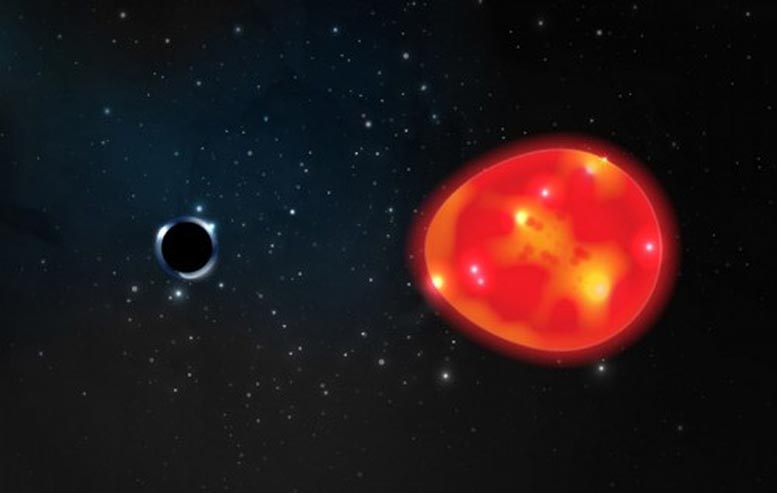Astronomers dub it “The Unicorn,” call it something special.
Scientists have discovered one of the smallest black holes on record – and the closest one to Earth found to date.
Researchers have dubbed it “The Unicorn,” in part because it is, so far, one of a kind, and in part because it was found in the constellation Monoceros – “The Unicorn.” The findings were published on April 21, 2021, in the journal Monthly Notices of the Royal Astronomical Society.
“When we looked at the data, this black hole – the Unicorn – just popped out,” said lead author Tharindu Jayasinghe, a doctoral student in astronomy at The Ohio State University and an Ohio State presidential fellow.
The Unicorn is about three times the mass of our sun – tiny for a black hole. Very few black holes of this mass have been found in the universe. This black hole is 1,500 light years away from Earth, still inside the Milky Way galaxy. And, until Jayasinghe started analyzing it, it was essentially hiding in plain sight.
The black hole appears to be a companion to a red giant star, meaning that the two are connected by gravity. Scientists can’t see the black hole – they are, by definition, dark, not only visually, but to the tools astronomers use to measure light and other wavelengths.
But in this case, they can see the black hole’s companion star. That star had been well-documented by telescope systems including KELT, run out of Ohio State; ASAS, the precursor to ASAS-SN, which is now run out of Ohio State, and TESS, a NASA satellite that searches for planets outside our solar system. Data about it had been widely available but hadn’t yet been analyzed in this way.
When Jayasinghe and the other researchers analyzed that data, they noticed something they couldn’t see appeared to be orbiting the red giant, causing the light from that star to change in intensity and appearance at various points around the orbit.
Something, they realized, was tugging at the red giant and changing its shape. That pulling effect, called a tidal distortion, offers astronomers a signal that something is affecting the star. One option was a black hole, but it would have to be small – less than five times the mass of our sun, falling into a size window that astronomers call the “mass gap.” Only recently have astronomers considered it a possibility that black holes of that mass could exist.
“When you look in a different way, which is what we’re doing, you find different things,” said Kris Stanek, study co-author, astronomy professor at Ohio State and university distinguished scholar. “Tharindu looked at this thing that so many other people had looked at and instead of dismissing the possibility that it could be a black hole, he said, ‘Well, what if it could be a black hole?’”
That tidal disruption is produced by the tidal force of an unseen companion – a black hole.
“Just as the moon’s gravity distorts the Earth’s oceans, causing the seas to bulge toward and away from the moon, producing high tides, so does the black hole distort the star into a football-like shape with one axis longer than the other,” said Todd Thompson, co-author of the study, chair of Ohio State’s astronomy department and university distinguished scholar. “The simplest explanation is that it’s a black hole – and in this case, the simplest explanation is the most likely one.”
The velocity of the red giant, the period of the orbit and the way in which the tidal force distorted the red giant told them the black hole’s mass, leading them to conclude that this black hole was about three solar masses, or three times that of the sun.
For about the last decade, astronomers and astrophysicists wondered whether they weren’t finding these black holes because the systems and approaches they used were not sophisticated enough to find them. Or, they wondered, did they simply not exist?
Then, about 18 months ago, many of the members of this Ohio State research team, led by Thompson, published a scientific article in the journal Science, offering strong evidence that these types of black holes existed. That discovery motivated Jayasinghe and others, both at Ohio State and around the world, to search in earnest for smaller black holes. And that evaluation led them to the Unicorn.
Finding and studying black holes and neutron stars in our galaxy is crucial for scientists studying space, because it tells them about the way stars form and die.
But finding and studying black holes is, almost by definition, difficult: Individual black holes don’t emit the same kind of rays that other objects emit in space. They are, to scientific equipment, electromagnetically silent and dark. Most known black holes were discovered because they interacted with a companion star, which created a lot of X-rays – and those X-rays are visible to astronomers.
In recent years, more large-scale experiments to try and locate smaller black holes have launched, and Thompson said he expects to see more “mass gap” black holes discovered in the future.
“I think the field is pushing toward this, to really map out how many low-mass, how many intermediate-mass and how many high-mass black holes there are, because every time you find one it gives you a clue about which stars collapse, which explode and which are in between,” he said.
Other Ohio State researchers who co-authored this paper include Chris Kochanek, Dominick Rowan, Patrick Vallely, David Martin and Laura Lopez.
Article From & Read More ( “The Unicorn” – Closest Black Hole to Earth Ever Discovered - SciTechDaily )https://ift.tt/3ncREFk
Science

No comments:
Post a Comment